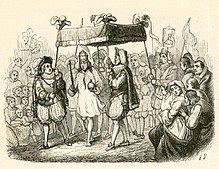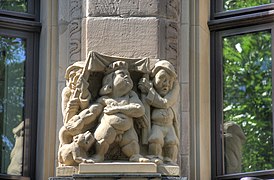The Emperor's New Clothes


The emperor's new clothes (Danish " Keizerens nye Klæder ") is a well-known art fairy tale by the Danish writer Hans Christian Andersen . It appeared on April 7, 1837 in an edition of the series "Märchen, für Kinder told" (Danish " Eventyr fortalte for Børn ").
Andersen's notes in his diary refer to an inspiration from Karl Eduard von Bülow's collection of novels . In this fairy tale, he translated a story ( “Seventh story: What a king met with three peelers” ) from the Spanish collection of Don Juan Manuel , which appeared in 1337 in the book “ El Conde Lucanor ” ( “The Count of Lucanor” ) and which Deception of the king and his court in a Moorish setting.
content
The fairy tale is about an emperor who has two swindlers weave new clothes for a lot of money. They show him that the clothes are not ordinary, but can only be seen by people who are worthy of their office and are not stupid. In fact, the crooks only pretend to weave and give the emperor the clothes. Out of vanity and inner insecurity, he does not mention that he cannot see the clothes himself, and the people to whom he presents his new clothes also show enthusiasm for the apparently beautiful fabrics. The dizziness is only revealed during a pageant, when a child says that the emperor has no clothes on, that this statement spreads through the crowd and that it finally calls out to the whole people. The emperor realizes that the people seem to be right, but decides to “hold out” and continues the parade with his court.
background
The story is occasionally cited as an example to criticize gullibility and the uncritical acceptance of alleged authorities and experts - comparable to clothes make people and the captain von Koepenick . For fear of his position and his reputation, no one speaks the obvious truth against their better judgment, not even the most loyal minister of the emperor; When faced with the decision “reputation and prosperity or truth”, one ultimately decides against the truth and for the material and economic advantages. In the medieval Spanish model, it is not about a lack of official capacity, as with Andersen, but the fabric is allegedly not seen by anyone who is not the son of the one who is considered his father (which, in addition to the shame, would also have fatal inheritance consequences). In addition, it is not an “innocent child” who speaks the truth, but a black horse servant who is aware that he is at the foot of the social hierarchy anyway, so that he is indifferent to whether he is actually the son of the one who is his father applies.
- Representation of the fairy tale in 5 small facade sculptures. Brückenstrasse 17, Cologne
Film adaptations
- 1961: The Dress , DEFA feature film, GDR , director: Konrad Petzold (ajar)
- 1987: The Emperor's New Clothes (The Emperor's New Clothes) , USA / Israel, directed by David Irving
- 1994: The Emperor's New Clothes , Germany / Czech Republic / Spain, fairy tale film directed by Juraj Herz
- 2001: I vestiti nuovi dell'imperatore , director: Alan Taylor , producer: Hanno Huth (converted to Napoleon)
- 2006: The emperor's new clothes - fashion, mob and monarchy, comedy from Die ProSieben Märchenstunde (Germany / Austria)
- 2010: The emperor's new clothes , Germany, fairy tale film of the 3rd season from the ARD series Six in one fell swoop
- 2010: SimsalaGrimm : The Emperor's New Clothes (cartoon series, episode 03x23)
Musical processing
- Hans Lofer alias Rudolf Hindemith - "The Emperor's New Clothes" (comic opera, circa 1934 - 1952)
- Eberhard Werdin - "The Emperor's New Clothes" (musical and scenic work, 1947)
- György Ránki - "Pomádé király új Ruhája" ("King Pomade's New Clothes") (Opera, Budapest 1953)
- Bertold Hummel - "The Emperor's New Clothes" (Chamber Opera, 1955) [3]
- Kuno Petsch - "The Emperor's New Clothes" (TV ballet, 1963)
- Juraj Beneš - "Cisárove nové šaty" (Opera, 1966)
- Rudolf Mors - "The Emperor's New Clothes" (incidental music, 1968)
- Reinhard Mey - "The Emperor's New Clothes" (Song, 1980)
- Sinéad O'Connor - "Emperor's New Clothes" (Song, 1990)
- Last Instance - "The Emperor" (Song, 2003)
- Spock's Beard - "The Emperor's Clothes" (Song, 2010)
- Haluk Levent - "Kral Ciplak" (Song, 2010)
- Sonata Arctica - "The Wolves Die Young" (Song, 2014)
- Saltatio Mortis - "The banker's new clothes" (interpretation, song, 2015)
- Panic! At The Disco - "Emperor's New Clothes" (Song, 2016)
- Megadeth - "The Emperor" (Song, 2016)
literature
- Albrecht Koschorke, Susanne Lüdemann, Thomas Frank: The emperor's new clothes . About the imaginary political rule. Texts, pictures, readings. Frankfurt am Main 2002, ISBN 3-596-15448-0 .
- Hans Christian Andersen: The Emperor's New Clothes , illustrated by Vitali Konstantinov , Jacoby & Stuart publishing house , Berlin 2013, ISBN 978-3-942787-07-9 .
- Hans Christian Andersen: The emperor's new clothes , retold by Arnica Esterl , illustrated by Anastassija Archipowa , Thienemann-Esslinger, Esslingen 2011, ISBN 978-3-480-22874-4 .
- Hans Christian Andersen: The emperor's new clothes and other fairy tales , edited by Ulrich Sonnenberg , illustrated by Rotraut Susanne Berner , Insel Taschenbuch, Frankfurt am Main 2007, ISBN 978-3-458-35024-8 .
Web links
- The emperor's new clothes in the Gutenberg-DE project
- The emperor's new clothes in the Gutenberg-DE project
- The emperor's new clothes at Zeno.org .
- Wiener Zeitung : On the relationship between Andersen's version and that in the Conde Lucanor
- The Emperor's New Clothes ( EPUB )
- The emperor's new clothes as an mp3 audio book on LibriVox
- Illustrations, text versions and interpretations of The Emperor's new Clothes on SurLaLuneFairyTales.com (archived version, May 2020)
Individual evidence
- ^ Hans Christian Andersen: The Emperor's New Clothes. Retrieved December 18, 2017 .
- ↑ Zeno: Spain, Don Juan Manuel: Der Graf Lucanor, 7. What a king with three peelers encounters. Retrieved December 19, 2017 .
- ↑ Papers from the previous international HCA conferences. Retrieved December 19, 2017 .
- ↑ Zeno: Spain, Don Juan Manuel: The Count Lucanor. Retrieved December 19, 2017 .
- ↑ See: Laurence De Looze :: Manuscript Diversity, Meaning, and Variance in Juan Manuel's El conde Lucanor ; University of Toronto Press, 2006, p. 129 [1] , as well as [2] Annette Madsen, Andersen Research Conference , Count Lucanor by Don Juan Manuel as Inspiration for Hans Christian Andersen and Other European Writers relevant article from the chapter Biography, Affinities and Influences , Andersen and the World, Odense 1999
- ↑ SimsalaGrimm - The emperor's new clothes. Retrieved October 25, 2019 (German).




